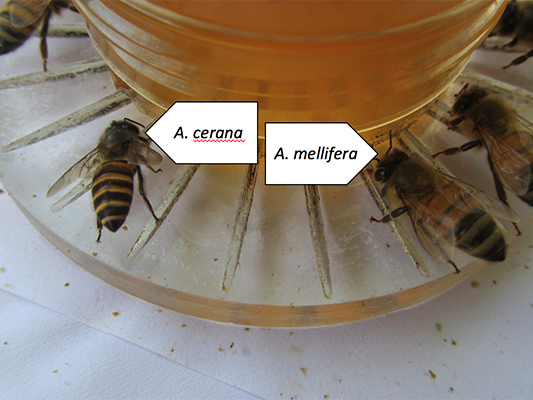
A swarm of Asian honey bees in Cairns, Queensland.
(Photo: R. Gloag)
Today there are two honey bee species that call Australia home: the European honey bee (Apis mellifera), introduced for beekeeping in the 1820s, and the Asian honey bee (Apis cerana) which was accidentally introduced to Far North Queensland (Cairns) sometime around 2007 and has established a feral population in that region.
Asian honey bees are close relatives of European honey bees and share many aspects of their behaviour: they nest in cavities, are generalist foragers, pollinate many of the plants they forage on and, of course, make honey. Indeed, they have been used for traditional bee-keeping in Asia for centuries.
Overall though, they are far less amenable to commercial bee-keeping than European honey bees. This is because they hoard comparably modest amounts of honey (particularly the tropical varieties), swarm frequently and readily abscond if disturbed. In fact, these latter traits seem to be particularly exaggerated in the invasive lineage of Far North Queensland, and may have contributed to the successful establishment of the population.
What risks do Asian honey bees pose to Australian beekeeping?

AHB vs EHB – Asian honey bees are smaller than Apis mellifera (Photo: R. Gloag)
Asian honey bees pose two risks to Australian Beekeepers.
- Vectors of pests, pathogens and disease.
Asian honey bees are the native host of the Varroa mite. Fortunately, the existing Asian honey bee population in Far North Queensland did not bring Varroa with it. There is an ongoing risk though that future incursions bring Varroa into Australia’s existing Asian honey bee population, or that new Varroa-carrying populations establish elsewhere in Australia. For example, a new incursion of Asian honey bees, carrying Varroa jacobsoni, was detected in Townsville in 2019 and is being monitored by Queensland Biosecurity.
The greatest risk of an incursion comes through swarms on shipping containers. The National Bee Pest Surveillance program acts to detect such incursions.
- Mating interference
Asian and European honey bees cannot hybridize. European honey bee queens will, however, sometimes mate with Asian honey bee males. The eggs fertilized by these matings fail to develop into larva. Each bee species congregates to mate at different locations and times of the day, which minimizes the incidence of interspecific matings. Also, because honey bee queens mate with 20 or more males, a couple of “wrong species” matings can occur without it having a severe impact on brood health. Mating interference will be a problem for European honey bees, however, when queens are mating in areas with higher densities of Asian honey bee males than males of her own species.
Is Australia’s population of Asian honey bees expanding?
Yes, but quite slowly. The Australian population of Asian honey bees is currently confined to a region of Far North Queensland centred on Cairns and the Atherton Tablelands. Researchers at The University of Sydney have conducted a “genetic post-mortem” on this invasive population and conclude that it was likely founded by the introduction of just a single swarm! This tells us that Asian honey bees pose a very significant biosecurity challenge, because even one swarm has the potential to initiate a new population. The good news though is that the current invasive population is highly inbred compared to populations in their native range, which is helping to slow its rate of spread.
In the absence of any new incursions, or any accidental long-distance relocations, Asian honey bees are likely to remain confined to Northern Queensland for quite some time.
You can report sightings of Asian honey bees in Queensland via the Department of Agriculture and Fisheries website and Australia-wide via the hotline 1800 084 881. You can also find up-to-date maps of the current distribution of Asian honey bees in Australia.
Video
Asian honey bees in Australia and how we determine just how big the population is. (Narrated by Ros Gloag)
Acknowledgements:
- Queensland Biosecurity, Department of Agriculture and Fisheries, Queensland Government.
- Ding G, Xu H, Oldroyd BP, Gloag RS (2017) Extreme polyandry aids the establishment of invasive populations of an invasive social insect. Heredity 119, 381-387
- Koetz AH. 2013 Ecology, behaviour and control of Apis cerana with a focus on relevance to the Australian incursion. Insects 4, 558-592.10.3390/insects4040558
- Oldroyd BP, Remnant E (2014) Interspecific mating between Apis cerana and Apis mellifera. Does it happen and what does it mean for the industry? Rural Industries Research and Development Corporation publication 14/049
- Remnant EJ, Koetz A, Tan K, Hinson E, Beekman M, Oldroyd BP. 2014 Reproductive interference between honeybee species in artificial sympatry. Molecular Ecology 23, 1096-1107.10.1111/mec.12669
- This article was written by Ros Gloag and reviewed by Nadine Chapman and Emily Remnant.

